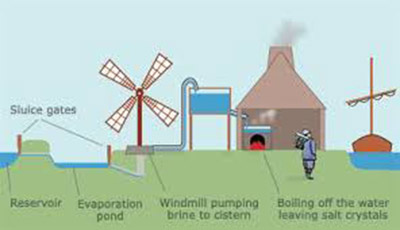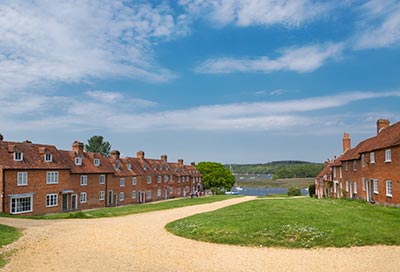Beaulieu River Salterns - their place in history
The lower tidal reaches of the Beaulieu River are rightly loved by walkers along the well-trodden path between Beaulieu and Buckler's Hard; birdwatchers at Needs Ore - part of the Beaulieu Estate and also part of the North Solent National Nature Reserve; yachtsmen; and many others who simply appreciate the natural splendour of this wonderful landscape.
But perhaps surprisingly, in addition to supporting the celebrated 18th century shipbuilding industry at Buckler's Hard, the river has also been of once prosperous salterns.
(1) Beaulieu Salterns
The presence of salterns a little downstream from Buckler's Hard continues to be recalled in place names such as Saltershill and Saltershill Copse, whilst across the Beaulieu River at Exbury is Salterns Copse.
On the Beaulieu River shore around Gins (A), a little to the west of St Leonard's; at Park (B) on the nearby Solent shore; and across the river at Exbury Point (C), from around the late 17th century salt was extracted from salt water by a process of evaporation, just as it was in many other places along the Hampshire coast.

The process was simple, at least in theory, although in practice it was less so. Salt water was typically drawn off into shallow pans bordered by low earthen banks and 'secured at the bottom with clay and gravel' or made from lead or iron.
Wind and sun caused at least some of the water to evaporate, leaving behind a relatively concentrated solution of brine that was then boiled to remove the remaining moisture, yielding a harvest of much prized salt.
In those far off days, salt thus extracted was a particularly important commodity used, for example, for culinary purposes, as part of the tanning process and, perhaps most significantly in the times before refrigeration, to preserve meat, fish and vegetables by reducing the potential for invasion by bacteria, fungi and other nasties.
The coastal salt industry throughout much of England declined from around the late 18th century and had largely disappeared by the mid-19th century, driven out of business by taxation, high costs associated with the purchase and transport of coal to fuel the boiling processes, and competition from abroad and from inland salt producers such as those based in Cheshire.
The salterns at Gins had ceased operation by the early 19th century, although the 1855 Kelly's Post Office Directory notes that: 'On the coast are salterns', which is similarly repeated in Kelly's 1880 Directory.
Now all that remains in many places as scant evidence of this once thriving trade are shallow, often water filled, depressions where once there were salt pans; eroded earthen banks; and low mounds on which wind pumps - frequently used to pump brine to the boiling houses - were located. And, of course, the saltern place names.
(There is a lot more information here about the operation of salterns - Lymington Salterns).
(2) The Salt Tax
Such was the importance of the salt industry that from 1694 right the way through to 1825, with a very brief break between 1730 and 1732, the production and sale of salt was taxed at what many considered to be punitive rates. Imported foreign salt was also heavily taxed, which must have provided at least some consolation for local salt producers.
The collection of the Salt Tax became something of an industry in itself as Salt Officers - civil servants of the time and a lowly form of excise men - were required to attend the salt pans to supervise the weighing and record the amounts of salt extracted for sale which, of course, determined the amount of tax to be paid.

Almost needless to say, the Salt Officers were not the most popular members of the community, although corruption and smuggling of this valuable commodity were almost inevitably rife, so-much-so that is has been questioned whether the revenue gathered from the tax justified the enormous cost of administration.
Perhaps reflecting the importance of the local salterns, in the first half of the 18th century three Salt Officers were amongst the first inhabitants of Montagu Town, the new town that was to become Buckler's Hard, and there was always at least one Salt Officer and more usually two present right the way through to 1825.
(Their relationship with the smugglers of Buckler's Hard must have been an interesting one, although maybe instances of corruption brought them together).
References:
Bucklers Hard - a rural shipbuilding centre: A.J. Holland
An Album of Old Beaulieu: Susan Tomkins
The changing technology of post medieval sea salt production in England: Jeremy Greenwood
The Salt Association
Various Wikipedia pages
Quick links
More links
Search this site

